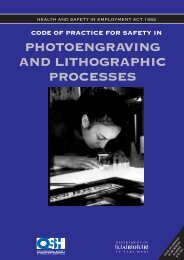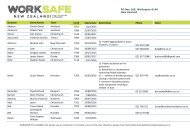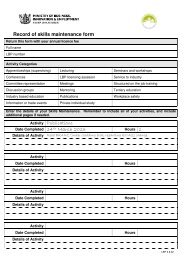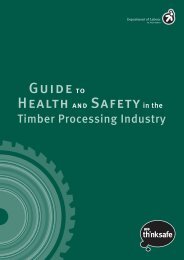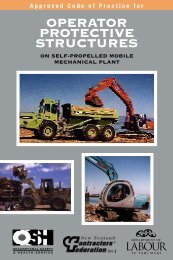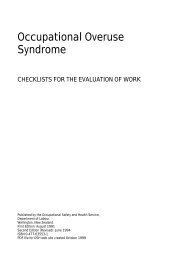Health and Safety in Welding - DOL 10157 - Business.govt.nz
Health and Safety in Welding - DOL 10157 - Business.govt.nz
Health and Safety in Welding - DOL 10157 - Business.govt.nz
You also want an ePaper? Increase the reach of your titles
YUMPU automatically turns print PDFs into web optimized ePapers that Google loves.
HEALTH ANDSAFETY INWELDING
Published by the Department of LabourWell<strong>in</strong>gtonNew Zeal<strong>and</strong>October 2006ISBN 0-478-28075-0
ContentsIntroduction 5Part 1: Weld<strong>in</strong>g hazards 6Part 2: Tra<strong>in</strong><strong>in</strong>g, qualifications <strong>and</strong> competency 9Part 3: Equipment selection, ma<strong>in</strong>tenance <strong>and</strong> safety 11Part 4: General health <strong>and</strong> safety <strong>in</strong> weld<strong>in</strong>g 12Part 5: Fire <strong>and</strong> explosion prevention <strong>and</strong> hot work 13Part 6: Personal protective equipment (PPE) 16Part 7: Fume <strong>and</strong> gas control 18Part 8: Local exhaust ventilation for weld<strong>in</strong>g processes 21Part 9: Electrical safety 24Part 10: Safe use of weld<strong>in</strong>g gases 26Part 11: Hazardous substances 28Part 12: Metal preparation 32Part 13: Weld<strong>in</strong>g <strong>in</strong> conf<strong>in</strong>ed spaces 33Part 14: Hot metals sparks 36Part 15: Radiation(ultraviolet, <strong>in</strong>frared <strong>and</strong> lasers) 37Part 16: Work<strong>in</strong>g technique 38Part 17: Noise <strong>and</strong> vibration 39Part 18: Manual h<strong>and</strong>l<strong>in</strong>g 40Part 19: H<strong>and</strong> tool fitness <strong>and</strong> safety 41Part 20: Specific requirements of the <strong>Health</strong> <strong>and</strong> <strong>Safety</strong><strong>in</strong> Employment Act 1992 42Part 21: Weld<strong>in</strong>g fume control summary worksheet 45
IntroductionWeld<strong>in</strong>g poses a range of both well known <strong>and</strong> subtle hazards to health <strong>and</strong>safety. These can act quickly or may show up only <strong>in</strong> the long term. They can berapidly fatal (electric shock or exposure to cadmium fumes) or have delayedeffects (lung changes over time).The Department of Labour has adopted the follow<strong>in</strong>g documents, publishedby the Weld<strong>in</strong>g Technical Institute of Australia (WTIA), as its ma<strong>in</strong> sources ofadvice about health <strong>and</strong> safety <strong>in</strong> weld<strong>in</strong>g:• <strong>Health</strong> <strong>and</strong> <strong>Safety</strong> <strong>in</strong> Weld<strong>in</strong>g 2004 – Technical Note 7 (TN7)• Fume M<strong>in</strong>imisation Guidel<strong>in</strong>es (FMG)Pr<strong>in</strong>ted copies of TN7 may be obta<strong>in</strong>ed from:Heavy Eng<strong>in</strong>eer<strong>in</strong>g Research AssociationPO Box 76134Manukau CityAuckl<strong>and</strong>Tel (09) 262 2885www.hera.co.<strong>nz</strong>The Fume M<strong>in</strong>imisation Guidel<strong>in</strong>es can be downloaded free from:www.wtia.com.au/fmg.htmlThis booklet summarises some of the ma<strong>in</strong> po<strong>in</strong>ts <strong>in</strong> the relevant sections ofboth the above publications.The Weld<strong>in</strong>g <strong>Health</strong> <strong>and</strong> <strong>Safety</strong> Assessment Tool, along with other related<strong>in</strong>formation, can be downloaded from the Department of Labour website:www.dol.<strong>govt</strong>.<strong>nz</strong>Provid<strong>in</strong>g health <strong>and</strong> safety <strong>in</strong>formation <strong>and</strong> advice for employees who carryout weld<strong>in</strong>g <strong>and</strong> cutt<strong>in</strong>g processes can be complex. There are many subtleties<strong>and</strong> traps for the unwary or <strong>in</strong>experienced. If you have any doubt that the<strong>in</strong>formation available on the Department of Labour website or <strong>in</strong> the WTIApublications covers your situation, get help from a specialist.<strong>Health</strong> <strong>and</strong> <strong>Safety</strong> <strong>in</strong> Weld<strong>in</strong>g
Part 1: Weld<strong>in</strong>g hazardsFires <strong>and</strong> explosionsThese are an ever-present hazard with many weld<strong>in</strong>g processes.BurnsWeld<strong>in</strong>g causes items to become hot – creat<strong>in</strong>g a risk of burns <strong>and</strong> fires fromhot metal <strong>and</strong> weld<strong>in</strong>g spatter.FumesFumes generated by different weld<strong>in</strong>g processes may range from be<strong>in</strong>g ofnuisance value to highly toxic. <strong>Health</strong> effects can occur very soon afterexposure (e.g. exposure to cadmium fumes can be fatal with<strong>in</strong> hours) or may notresult until after many years. Fume control requires appropriate ventilationequipment <strong>and</strong> may require advice from a specialist.Electric shockWeld<strong>in</strong>g processes that use electricity pose both obvious <strong>and</strong> subtle hazardsof electric shock – which can be fatal. St<strong>and</strong>ard precautions, as expla<strong>in</strong>ed <strong>in</strong>this book, need to be taken dur<strong>in</strong>g the use of weld<strong>in</strong>g equipment, <strong>and</strong> expertassistance can be needed <strong>in</strong> some circumstances to identify subtle hazards.Equipment selection, set-up <strong>and</strong> ma<strong>in</strong>tenance is important <strong>and</strong> may requirespecialist advice to ensure safety.Compressed gasesCompressed gases <strong>in</strong> cyl<strong>in</strong>ders pose a number of hazards. Methods for theirsafe use are outl<strong>in</strong>ed <strong>in</strong> TN7 chapter 5.Hazardous substancesHazardous substances used dur<strong>in</strong>g some weld<strong>in</strong>g processes can require highlyspecialised methods of control (e.g. the extremely toxic hydrofluoric acid.) <strong>Health</strong> <strong>and</strong> <strong>Safety</strong> <strong>in</strong> Weld<strong>in</strong>g
Toxic gasesToxic gases may be:• used <strong>in</strong>, or generated by, the process (e.g. acetylene, ozone, nitrogen oxides,carbon monoxide)• generated when coat<strong>in</strong>gs on metal surfaces are heated (e.g. epoxy res<strong>in</strong>s,degreas<strong>in</strong>g agents, pa<strong>in</strong>t)• generated when the arc flash <strong>and</strong> some degreas<strong>in</strong>g chemicals or pa<strong>in</strong>tsreact (e.g. phosgene or phosph<strong>in</strong>e).Precautions for prevent<strong>in</strong>g these hazards from caus<strong>in</strong>g harm are outl<strong>in</strong>ed <strong>in</strong>TN7 chapters 5 <strong>and</strong> 10.SuffocationInert gases used dur<strong>in</strong>g weld<strong>in</strong>g can flood an area <strong>and</strong> lower its oxygen content,especially <strong>in</strong> conf<strong>in</strong>ed spaces. Suffocation can result.RadiationArc flash is a well known hazard of weld<strong>in</strong>g. St<strong>and</strong>ard precautions (see part 15)should be used to prevent eye <strong>and</strong> sk<strong>in</strong> exposure – both for the worker <strong>and</strong> forpeople <strong>in</strong> the vic<strong>in</strong>ity. Reflect<strong>in</strong>g surfaces make exposure to radiation morelikely.Heat stressWork<strong>in</strong>g for long periods <strong>in</strong> hot environments can lead to distress <strong>and</strong> <strong>in</strong> anextreme, fatal heat stroke. Specialist advice must be sought if welders work <strong>in</strong>hot environments. (See TN7 chapter 23.)DustAssociated processes (gr<strong>in</strong>d<strong>in</strong>g) may generate hazardous levels of dust.Noise <strong>and</strong> vibrationNoise <strong>and</strong> vibration levels dur<strong>in</strong>g some weld<strong>in</strong>g processes can be high <strong>and</strong>should be controlled <strong>and</strong>/or appropriate hear<strong>in</strong>g protection should be worn.<strong>Health</strong> <strong>and</strong> <strong>Safety</strong> <strong>in</strong> Weld<strong>in</strong>g
Manual h<strong>and</strong>l<strong>in</strong>gSome weld<strong>in</strong>g processes may <strong>in</strong>volve heavy <strong>and</strong> or repetitive h<strong>and</strong>l<strong>in</strong>g.Specific processesSeveral processes, not covered by this booklet, are discussed <strong>in</strong> TN7:• thermit weld<strong>in</strong>g• laser weld<strong>in</strong>g• electroslag weld<strong>in</strong>g• plasma cutt<strong>in</strong>g• resistance weld<strong>in</strong>g• electron beam weld<strong>in</strong>g• braz<strong>in</strong>g <strong>and</strong> solder<strong>in</strong>g• thermal lanc<strong>in</strong>g. <strong>Health</strong> <strong>and</strong> <strong>Safety</strong> <strong>in</strong> Weld<strong>in</strong>g
Part 2: Tra<strong>in</strong><strong>in</strong>g, qualifications <strong>and</strong>competencyGeneralWeld<strong>in</strong>g <strong>in</strong>volves a wide range of processes carried out <strong>in</strong> a variety of work<strong>in</strong>gconditions.Certa<strong>in</strong> work, especially where safety critical items are fabricated, requires ahigh level of skill <strong>and</strong> competency (e.g. weld<strong>in</strong>g pressure vessels) whereas a highskill level may not be so critical <strong>in</strong> some general purpose weld<strong>in</strong>g.Only workers with appropriate levels of competence <strong>and</strong> skill should do weld<strong>in</strong>g.They must know:• the right way to do the work• the hazards of the work• how to prevent those hazards caus<strong>in</strong>g harm.Competence <strong>in</strong> weld<strong>in</strong>g may be shown by an appropriate qualification issued bya registered tra<strong>in</strong><strong>in</strong>g organisation (such as an <strong>in</strong>dustry tra<strong>in</strong><strong>in</strong>g organisation(ITO)) or relevant unit st<strong>and</strong>ards for weld<strong>in</strong>g from the National QualificationsFramework. Welders should not use equipment for which they are not certified.Welders should be tra<strong>in</strong>ed <strong>in</strong> the use of fire ext<strong>in</strong>guishers <strong>and</strong> hot work permits,if they are used.The value of experienceWeld<strong>in</strong>g is often a complex, safety critical operation <strong>and</strong> a great deal ofknowledge may be required to provide for all aspects of health <strong>and</strong> safety.This knowledge will not come entirely by read<strong>in</strong>g or tra<strong>in</strong><strong>in</strong>g. Experience, skill <strong>and</strong>practice should also <strong>in</strong>form safe work<strong>in</strong>g practices.This means that weld<strong>in</strong>g safety should be considered a team effort, with teamleaders actively coach<strong>in</strong>g team members <strong>and</strong> team members referr<strong>in</strong>g toknowledgable team members if they are not sure of correct health <strong>and</strong> safetypractices. This is especially important when do<strong>in</strong>g new tasks.<strong>Health</strong> <strong>and</strong> <strong>Safety</strong> <strong>in</strong> Weld<strong>in</strong>g
Relevant st<strong>and</strong>ardsSt<strong>and</strong>ards apply<strong>in</strong>g to weld<strong>in</strong>g processes <strong>in</strong>clude:• NZS 4711: 1984. Qualification tests for metal-arc welders.• AS/NZS 1338.1:1992 Filters for eye protectors–Filters for protectionaga<strong>in</strong>st radiation generated <strong>in</strong> weld<strong>in</strong>g <strong>and</strong> allied operations• The AS/NZS 1554 series. Covers: Weld<strong>in</strong>g of steel structures; Weld<strong>in</strong>g ofhigh strength quenched <strong>and</strong> tempered steels; Weld<strong>in</strong>g of steel structures tohigh levels of fatigue load<strong>in</strong>g; Weld<strong>in</strong>g sta<strong>in</strong>less steel for structural purposes• AS 1796–Certification of welders <strong>and</strong> weld<strong>in</strong>g supervisors• AS 2214–Certification of weld<strong>in</strong>g supervisors – structural steel weld<strong>in</strong>g.• AS/NZS 3100:2002 Approval <strong>and</strong> test specification – General requirementsfor electrical equipment• AS/NZS 3195:2002 Approval <strong>and</strong> test specification – Portable mach<strong>in</strong>es forelectric arc weld<strong>in</strong>g <strong>and</strong> allied processes• AS/NZS 1995:2003 Weld<strong>in</strong>g cables• AS/NZS 3957:2006 Light-transmitt<strong>in</strong>g screens <strong>and</strong> curta<strong>in</strong>s for weld<strong>in</strong>goperations.The New Zeal<strong>and</strong> Qualifications Authority (NZQA) publish a list of over 30 unitst<strong>and</strong>ards for weld<strong>in</strong>g processes. This <strong>in</strong>cludes US 21907 Demonstrate <strong>and</strong>apply knowledge of safe weld<strong>in</strong>g procedures under supervision, <strong>and</strong> there arealso health <strong>and</strong> safety components <strong>in</strong> each of the unit st<strong>and</strong>ards listed. Seethe Department of Labour website.10 <strong>Health</strong> <strong>and</strong> <strong>Safety</strong> <strong>in</strong> Weld<strong>in</strong>g
Part 3: Equipment selection, ma<strong>in</strong>tenance<strong>and</strong> safetyConsult TN7 for details ofselect<strong>in</strong>g the right equipment forthe particular weld<strong>in</strong>g processbe<strong>in</strong>g carried out.Generally, the manufactureror supplier of the equipmentwill give detailed directions forsett<strong>in</strong>g up the equipment, safeusage <strong>and</strong> ma<strong>in</strong>tenance. Thesedirections should be followed.angle gr<strong>in</strong>der<strong>Health</strong> <strong>and</strong> <strong>Safety</strong> <strong>in</strong> Weld<strong>in</strong>g 11
Part 4: General health <strong>and</strong> safety<strong>in</strong> weld<strong>in</strong>gGood housekeep<strong>in</strong>gGood housekeep<strong>in</strong>g, especially the removal of combustible materials, isessential.GasIf you can smell gas – don’t light any gas torches or use electric weld<strong>in</strong>gequipment, but don’t rely wholly on your sense of smell to warn you.Eye protectionWear eye protection <strong>and</strong> cover bare sk<strong>in</strong>. Be aware that:• arc flash can occur through the side of the eye• arc flash can cause ‘sunburn’ on exposed sk<strong>in</strong>.Hot surfacesMark hot surfaces as such. Better still, assume everyth<strong>in</strong>g is hot.First aidIn addition to st<strong>and</strong>ard tra<strong>in</strong><strong>in</strong>g, first-aiders <strong>in</strong> weld<strong>in</strong>g situations should knowabout the symptoms of electric shock, arc flash <strong>and</strong> the consequences ofexposure to heated coat<strong>in</strong>gs on metals (e.g. when galvanised metal is welded).12 <strong>Health</strong> <strong>and</strong> <strong>Safety</strong> <strong>in</strong> Weld<strong>in</strong>g
Part 5: Fire <strong>and</strong> explosion prevention<strong>and</strong> hot workGeneralPrevent the ignition of combustible materials that may be near the weld<strong>in</strong>gprocess. If weld<strong>in</strong>g a metal wall or partition (or if weld<strong>in</strong>g near one), you shouldcheck what is beh<strong>in</strong>d it.Know how to use gas equipment safely.• Oxygen under pressure can cause the spontaneous combustion of oil orgrease. Keep all regulators <strong>and</strong> air hoses free of oil <strong>and</strong> grease, <strong>and</strong> avoidgett<strong>in</strong>g grease/oil on h<strong>and</strong>s, gloves <strong>and</strong> overalls.• Use the right gases for the situation. Never substitute oxygen forcompressed air.• In conf<strong>in</strong>ed spaces, the risk of fuel gases <strong>and</strong> air comb<strong>in</strong><strong>in</strong>g to ignite orexplode is <strong>in</strong>creased. Don’t allow weld<strong>in</strong>g gas supply l<strong>in</strong>es to lie <strong>in</strong> a conf<strong>in</strong>edspace where they may leak.Keep appropriate fire ext<strong>in</strong>guishers available <strong>and</strong> visible at all times. Make surestaff are tra<strong>in</strong>ed <strong>in</strong> their use.Consult the relevant sections of TN7 (chapters 5 <strong>and</strong> 16), NZS 4781:1973 Codeof practice for safety <strong>in</strong> weld<strong>in</strong>g <strong>and</strong> cutt<strong>in</strong>g <strong>and</strong> AS 2865 Hot work.Work on drums <strong>and</strong> tanksSevere explosions <strong>and</strong> fires, many result<strong>in</strong>g <strong>in</strong> fatalities, have been caused byweld<strong>in</strong>g, cutt<strong>in</strong>g, braz<strong>in</strong>g, solder<strong>in</strong>g on pipes, tanks, drums, <strong>and</strong> similar vesselswhich previously conta<strong>in</strong>ed flammable materials.Conta<strong>in</strong>ers which have held petrol, white spirit or other flammable substancesare highly dangerous to work on <strong>and</strong> a p<strong>in</strong>-po<strong>in</strong>t of heat can be enough to setoff an explosion or fire. Equally dangerous are pipes or conta<strong>in</strong>ers which haveheld substances like l<strong>in</strong>seed oil, soap, diesel oil, acids that react with metals toproduce hydrogen, or combustible solids which may have left a residue of dust.It is essential to remove all residues. The preferred method is to steam clean<strong>and</strong> then either fill with an <strong>in</strong>ert gas such as carbon dioxide or nitrogen, or fill<strong>Health</strong> <strong>and</strong> <strong>Safety</strong> <strong>in</strong> Weld<strong>in</strong>g 13
with water, leav<strong>in</strong>g a very small vented space at the po<strong>in</strong>t where the repairis to be made. (Allow for the expansion of liquid <strong>in</strong> small-bore pipes.) Wash<strong>in</strong>gconta<strong>in</strong>ers with cold or hot water, or blow<strong>in</strong>g with air are both <strong>in</strong>effective.Clean<strong>in</strong>g with trichloroethylene must be carried out with care, s<strong>in</strong>ce it is toxic<strong>and</strong> decomposes on heat<strong>in</strong>g <strong>and</strong> may form phosgene gas.Welders should study the booklet Hot Work on Tanks <strong>and</strong> Drums (obta<strong>in</strong>able atany Department of Labour office) before carry<strong>in</strong>g out such repairs. Also, seeTN7 chapter 21. A sample hot work permit follows:14 <strong>Health</strong> <strong>and</strong> <strong>Safety</strong> <strong>in</strong> Weld<strong>in</strong>g
HOT WORK PERMITTO BE DISPLAYED ON THE WELDING ORCUTTING APPARATUS AND RETURNEDTO THE RESPONSIBLE OFFICER ONCOMPLETION OF THE WORK.Permission granted to: (Name)On the left is an example of a hot workpermit which can be pr<strong>in</strong>ted on a card <strong>and</strong>attached to a weld<strong>in</strong>g trolley.Below is an example of the hot work permitadvocated <strong>in</strong> NZS 4781.To use (Type of equipment)HOT WORK PERMITIn (location)On (date)From (time)To (timecompleted)1. All combustible materialsremoved or made safe2. No flammable liquids, vapours,gases or dusts present3. Ext<strong>in</strong>guishers/hoses providedon site4. Operator knows how to use fireequipment5. Operator knows location oftelephone/fire alarm6. Site <strong>in</strong>spected after completionof work.Permit issued by (responsible officer)................................................................................(Name)is hereby authorised to carry outcutt<strong>in</strong>g*, burn<strong>in</strong>g*, weld<strong>in</strong>g*(*cross out where not applicable)Other work on................................................................................(Plant or equipment)as from................................................................................(Date, time)Signed................................................................................Factory managerI have <strong>in</strong>spected the work. The permithas been withdrawn as from as from................................................................................(Date, time)Signed................................................................................Factory manager (or nom<strong>in</strong>ee)<strong>Health</strong> <strong>and</strong> <strong>Safety</strong> <strong>in</strong> Weld<strong>in</strong>g 15
Part 6: Personal protectiveequipment (PPE)St<strong>and</strong>ard personal protectiveequipment (PPE) for the variety ofweld<strong>in</strong>g processes <strong>in</strong>cludes:• weld<strong>in</strong>g helmet with a suitable arcflash filter, not less than shade 10.(Note: A weld<strong>in</strong>g helmet does notprotect aga<strong>in</strong>st fumes.)• eye protection – <strong>and</strong> use darkcloth<strong>in</strong>g to avoid ultraviolet (UV)rays• flameproof overalls with longsleeves <strong>and</strong> neck fasten<strong>in</strong>gs• gloves (AS/NZS 2161 –Occupational protective gloves)• apron• respiratory protectionRespiratorhear<strong>in</strong>gprotectionglovesFull PPEweld<strong>in</strong>g helmet witharc flash filtercapgogglesdark, flame-proofcloth<strong>in</strong>g with longsleeves <strong>and</strong> neckfasten<strong>in</strong>gsapronsteel-cappedbootsWeld<strong>in</strong>g without this protection mayallow bare sk<strong>in</strong> to be exposed to theweld<strong>in</strong>g arc.• hear<strong>in</strong>g protectionEye protectionHear<strong>in</strong>g protectionEye protection may be worn undera weld<strong>in</strong>g helmet for additionalprotection. Eye protection must beworn when us<strong>in</strong>g a tool such as achipp<strong>in</strong>g hammer or powered gr<strong>in</strong>derto prepare or deslag metal.16 <strong>Health</strong> <strong>and</strong> <strong>Safety</strong> <strong>in</strong> Weld<strong>in</strong>g
Additional items of protectivecloth<strong>in</strong>g may <strong>in</strong>clude:• a capcap• neck cover<strong>in</strong>g (for protectionfrom arc flash <strong>in</strong> conf<strong>in</strong>edspaces)• spats or legg<strong>in</strong>gs• steel-capped boots (AS/NZS2210 Guide to occupationalprotective footwear).Additional respiratory protectionmay be required (e.g. when weld<strong>in</strong>gspats orlegg<strong>in</strong>gsgalvanised metal or when cadmiumis present <strong>in</strong> weld<strong>in</strong>g rods). Thismay range from simple filtermasks that fit under the weld<strong>in</strong>ghelmet to powered air purify<strong>in</strong>grespirators. Specialist help may beneeded to select, fit <strong>and</strong> ma<strong>in</strong>ta<strong>in</strong>these items. Please refer to theWelderwith PPEsteelcappedbootsDepartment of Labour publication A Guide to Respiratory Protection; AS/NZS1715:1994 Selection, use <strong>and</strong> ma<strong>in</strong>tenance of respiratory protective devices; <strong>and</strong>TN7, chapter 19.Personal protective equipment must be paid for by the employer – see section10(2) of the <strong>Health</strong> <strong>and</strong> <strong>Safety</strong> <strong>in</strong> Employment Act 1992. Some protectiveequipment is designed to protect people <strong>in</strong> the vic<strong>in</strong>ity from arc flash – such asportable weld<strong>in</strong>g screens. These should be dark <strong>in</strong> colour as sh<strong>in</strong>y surfaces canreflect a significant amount of the arc flash.<strong>Health</strong> <strong>and</strong> <strong>Safety</strong> <strong>in</strong> Weld<strong>in</strong>g 17
Part 7: Fume <strong>and</strong> gas controlExposure to weld<strong>in</strong>g gases <strong>and</strong> fumes can be fatal. Unsafe atmospheres <strong>and</strong>toxic weld<strong>in</strong>g gases <strong>and</strong> fumes may create a risk of discomfort, suffocation, fire<strong>and</strong> poison<strong>in</strong>g.Nuisance dusts <strong>in</strong>clude iron <strong>and</strong>alum<strong>in</strong>ium oxides generated <strong>in</strong> largequantities, which should be controlledat source.Examples of tox<strong>in</strong>s are ozone, carbonmonoxide, nitrogen oxides <strong>and</strong> fumesfrom highly toxic metals <strong>in</strong>clud<strong>in</strong>gcadmium, z<strong>in</strong>c, beryllium, lead,chromium, nickel, manganese <strong>and</strong>copper. Fumes from some of thesemetals can cause cancer.FumesInert shield<strong>in</strong>g gases may pose risksof oxygen depletion <strong>and</strong> thereforesuffocation, especially <strong>in</strong> conf<strong>in</strong>edspaces.Some weld<strong>in</strong>g gases present risks of fire <strong>and</strong> explosion.Weld<strong>in</strong>g <strong>in</strong> conf<strong>in</strong>ed spaces may <strong>in</strong>crease the risks of each of these types ofhazard (see Part 13: Weld<strong>in</strong>g <strong>in</strong> conf<strong>in</strong>ed spaces).Preparation of metal surfaces may cause toxic fumes or vapours to bereleased. Examples <strong>in</strong>clude:• when pa<strong>in</strong>ts or plastic coat<strong>in</strong>gs are heated• if degreas<strong>in</strong>g agents, oil or grease are not removed from metal surfaces• weld<strong>in</strong>g car parts pa<strong>in</strong>ted with isocyanate pa<strong>in</strong>ts.The <strong>in</strong>teraction of the weld<strong>in</strong>g arc <strong>and</strong> certa<strong>in</strong> degreas<strong>in</strong>g agents can generatethe highly toxic gas phosgene.Fumes generated by flux<strong>in</strong>g agents <strong>in</strong> weld<strong>in</strong>g rods, weld<strong>in</strong>g pastes <strong>and</strong> silverbraz<strong>in</strong>g fluxes can cause allergic reactions.18 <strong>Health</strong> <strong>and</strong> <strong>Safety</strong> <strong>in</strong> Weld<strong>in</strong>g
You cannot rely on the sense of smell to detect any of these hazards. Somecannot be smelt at all <strong>and</strong> the sense of smell can become <strong>in</strong>sensitive to thoseodours it can detect.Special efforts to ensure adequate ventilation (especially <strong>in</strong> conf<strong>in</strong>ed spaces)<strong>and</strong> to control fumes are necessary.Basic methods of gas <strong>and</strong> fume controlCreate less fumes• Use a weld<strong>in</strong>g technology that creates less fumes (<strong>and</strong> is also more costeffective). For example, substitute manual weld<strong>in</strong>g with gas metal arc (MIG)weld<strong>in</strong>g, or substitute MIG with submerged arc weld<strong>in</strong>g.• Use electrodes that create less fumes.• Reduce the current to the m<strong>in</strong>imum possible.• An approximate decreas<strong>in</strong>g order of fume generation is:Manual metal arc weld<strong>in</strong>g(MMAW)Most fumeGas metal arc weld<strong>in</strong>g(MIG)Less fumeGas tungsten arc weld<strong>in</strong>g(TIG)Least fumeSubstitute dangerous work methods• Substitute a dangerous substance with a less dangerous one.• Arrange the work so that hot gases <strong>and</strong> fumes do not rise <strong>in</strong>to the worker’sface.• Automate where appropriate.Use dilution ventilationThis method disperses fumes <strong>and</strong> gases from near the worker to the widerworkplace. Plac<strong>in</strong>g extraction fans <strong>in</strong> walls <strong>and</strong> ceil<strong>in</strong>gs, keep<strong>in</strong>g doors open orhav<strong>in</strong>g a large volume of room space for each worker are common approaches.<strong>Health</strong> <strong>and</strong> <strong>Safety</strong> <strong>in</strong> Weld<strong>in</strong>g 19
This method is suitable only for low toxicity fumes <strong>and</strong> is not suitable wheretoxic substances or metals are generated or welded.See TN7 Section 17.4 <strong>and</strong> Table 17.1.Use local exhaust ventilationThis is the preferred option.Local exhaust ventilation systems capture fumes <strong>and</strong> gases near the po<strong>in</strong>twhere they are generated. This method is essential for many weld<strong>in</strong>g processes.See TN7 Chapter 17 <strong>and</strong> the WTIA Fume M<strong>in</strong>imisation Guidel<strong>in</strong>es <strong>and</strong> part 8 ofthis guide for more detail.Limit the exposure periodThis adm<strong>in</strong>istrative control may not prevent toxic effects from short-termexposure <strong>and</strong> is unsuitable for toxic contam<strong>in</strong>ants.It may be essential when work<strong>in</strong>g <strong>in</strong> conf<strong>in</strong>ed spaces. See part 13: Weld<strong>in</strong>g <strong>in</strong>conf<strong>in</strong>ed spaces.Use personal protective equipment (PPE)Certa<strong>in</strong> PPE is st<strong>and</strong>ard <strong>in</strong> weld<strong>in</strong>g processes, but should be regardedas a method of last resort for fume control, where other methods proveunsatisfactory. See details above <strong>and</strong> <strong>in</strong> part 8: Local exhaust ventilation forweld<strong>in</strong>g processes.20 <strong>Health</strong> <strong>and</strong> <strong>Safety</strong> <strong>in</strong> Weld<strong>in</strong>g
Part 8: Local exhaust ventilationfor weld<strong>in</strong>g processesChapter 17 of TN7 <strong>and</strong> the FumeM<strong>in</strong>imisation Guidel<strong>in</strong>es cover this topicfully. These notes aim to give a briefoverview of weld<strong>in</strong>g ventilation bestpractice.The amount of fume generated dependson:• the process be<strong>in</strong>g used• the type of weld<strong>in</strong>g consumables(rods) used• what is be<strong>in</strong>g welded• any coat<strong>in</strong>gs on it• the temperature• the amperage <strong>and</strong> voltage of the weld<strong>in</strong>g current• gas <strong>and</strong> arc temperatures• heat <strong>in</strong>put <strong>and</strong>• the duration <strong>and</strong> frequency of the work.After these aspects of the task have been chosen to m<strong>in</strong>imise fumegeneration, some fumes may rema<strong>in</strong>. The best way to prevent exposure is toprovide appropriate ventilation.Mechanical dilution ventilationThis will be adequate only <strong>in</strong> the circumstances described <strong>in</strong> TN7 Section 17.4<strong>and</strong> Table 17.1.Portable fans blow<strong>in</strong>g fume away from the welder’s breath<strong>in</strong>g zone are one wayof provid<strong>in</strong>g exhaust fume control. A capture velocity of 0.5 m/s is required.Velocities up to 2.0 m/s should not <strong>in</strong>terfere with shield<strong>in</strong>g gases. This may notbe suitable <strong>in</strong> some circumstances.<strong>Health</strong> <strong>and</strong> <strong>Safety</strong> <strong>in</strong> Weld<strong>in</strong>g 21
Local exhaust ventilationLocal exhaust ventilation has the follow<strong>in</strong>gcomponents:• A hood, a duct system, an air-clean<strong>in</strong>gdevice, an exhaust fan <strong>and</strong> a stack.• A ventilation slot at the rear of theweld<strong>in</strong>g bench. Precise specifications forthe air-flow rates for different types <strong>and</strong>sizes of capture hoods can be found <strong>in</strong>TN7.• Specific purpose ventilation. Fixed hoodscan be located at po<strong>in</strong>ts where weld<strong>in</strong>goccurs for example, where componentsto be welded are held <strong>in</strong> jigs.• Ventilation equipment mounted on the weld<strong>in</strong>g gun. Care needs to be takenover the design (for worker acceptance) <strong>and</strong> the disturbance of shield<strong>in</strong>ggases, if they are used. Regular ma<strong>in</strong>tenance is essential if this equipment isto work properly.• Relocatable exhaust hoods connected to fans <strong>and</strong> air-cleaners by flexibletub<strong>in</strong>g. These may connect to a fixed fan or vacuum cleaner-type unit. Theyallow the welder to reposition the suction <strong>in</strong>let as weld<strong>in</strong>g proceeds.Captur<strong>in</strong>g fumes when the po<strong>in</strong>t of weld<strong>in</strong>g moves may be more difficult, but isimportant when exposure is significant.Local exhaust ventilation may be required whenever:• weld<strong>in</strong>g takes place <strong>in</strong> conf<strong>in</strong>ed spaces• the metals listed <strong>in</strong> TN7 Table 17.2 are be<strong>in</strong>g welded.Us<strong>in</strong>g portablefume exhaustWhenever workers may be exposed to beryllium or cadmium, local exhaustventilation <strong>and</strong> personal respiratory equipment must be provided, such is theirtoxicity, no matter where weld<strong>in</strong>g is carried out.Coat<strong>in</strong>gs on metals often give rise to hazardous exposures. The correctidentification of metal coat<strong>in</strong>gs <strong>and</strong> their removal is the preferred controlmeasure. Local exhaust ventilation (<strong>and</strong> possibly personal protective22 <strong>Health</strong> <strong>and</strong> <strong>Safety</strong> <strong>in</strong> Weld<strong>in</strong>g
equipment) will be essential to control toxic dusts/fumes if these coat<strong>in</strong>gscannot be removed.Special measures to control toxic products (phosgene <strong>and</strong> phosph<strong>in</strong>e) thatcan be generated when metals contam<strong>in</strong>ated with degreas<strong>in</strong>g agents <strong>and</strong>phosphate pa<strong>in</strong>ts (respectively) are welded, are described <strong>in</strong> TN7 part 17.11.Equipment may be needed to measure the levels of gases such as carbonmonoxide, ozone <strong>and</strong> nitrogen oxides.The fume control worksheet shown <strong>in</strong> part 21 can <strong>in</strong>dicate the level ofprotection required <strong>in</strong> other circumstances.<strong>Health</strong> <strong>and</strong> <strong>Safety</strong> <strong>in</strong> Weld<strong>in</strong>g 23
Part 9: Electrical safetySee TN7 chapters 4 <strong>and</strong> 14 for details about general electrical safety <strong>and</strong> thespecific electrical safety measures required for each different weld<strong>in</strong>g process.Ensure equipment is constructed to the relevant st<strong>and</strong>ards (AS 1966 <strong>and</strong>AS/NZS 3195).Ask the advice of the weld<strong>in</strong>g equipment supplier or an appropriately qualifiedspecialist when purchas<strong>in</strong>g <strong>and</strong>/or <strong>in</strong>stall<strong>in</strong>g weld<strong>in</strong>g equipment. Some basicprecautions follow.Equipment electrical safety• ensure the equipment has the correctcurrent capacity• provide an isolat<strong>in</strong>g switch• where a flammable gas or solvent ispresent, an electrical spark mightcause an explosion, so weld<strong>in</strong>g shouldnot occur24 <strong>Health</strong> <strong>and</strong> <strong>Safety</strong> <strong>in</strong> Weld<strong>in</strong>gAngle gr<strong>in</strong>der• take care to preserve electricalpolarity when us<strong>in</strong>g two weld<strong>in</strong>g mach<strong>in</strong>es on electrically connected metals• use a weld<strong>in</strong>g mach<strong>in</strong>e with an automatic cut-out to ensure the duty cyclecannot be exceeded• <strong>in</strong>spect equipment regularly (AS/NZS 3100:2002 Approval <strong>and</strong> testspecification – General requirements for electrical equipment <strong>and</strong>AS/NZS 3195:2002 Approval <strong>and</strong> test specification – Portable mach<strong>in</strong>es forelectric arc weld<strong>in</strong>g <strong>and</strong> allied processes). Do not use equipment with frayedor cracked leads, connectors or fitt<strong>in</strong>gs or broken switches <strong>and</strong> coverplates. Do not allow them to be used while wait<strong>in</strong>g for repairs(see AS/NZS 1995:2003 Weld<strong>in</strong>g cables). Leads need to be tested <strong>and</strong>tagged• select an appropriate rod holder (AS 2826-1985: Manual metal-arc weld<strong>in</strong>gelectrode holders)• check the electrical safety of the rod holder or weld<strong>in</strong>g h<strong>and</strong>-pieceregularly – ma<strong>in</strong>ta<strong>in</strong> or replace as required
• use the shortest possible leads <strong>and</strong> ensure they are capable of carry<strong>in</strong>g therequired current safely• use a residual current device (RCD) when us<strong>in</strong>g h<strong>and</strong>-held power tools• use appropriately-rated powerboards rather than double adaptors orpiggyback plugs.Safe use of equipment• be aware of weld<strong>in</strong>g where water may be present (showers, kitchens, boats,spas, swimm<strong>in</strong>g pools etc.)• never twist or knot a lead, bend it sharply, tack it to a wall or drape it overyour body• dry your h<strong>and</strong>s before weld<strong>in</strong>g. If you get sweaty, dry off, take a break <strong>and</strong>use a wooden duckboard to <strong>in</strong>sulate yourself• disconnect electrical equipment immediately after use• pull on the plug, not the lead, to unplug equipment• use weld<strong>in</strong>g gloves – keep them <strong>and</strong> any protective cloth<strong>in</strong>g dry. Don’t work<strong>in</strong> the ra<strong>in</strong>. Don’t hold electrodes under the armpits.If you use a petrol motor generator to power a weld<strong>in</strong>g set, be aware thatcarbon monoxide can kill quickly. Don’t use <strong>in</strong> conf<strong>in</strong>ed spaces, <strong>in</strong>clud<strong>in</strong>g onesthat appear to be ventilated, such as a park<strong>in</strong>g garage.TN 22, Weld<strong>in</strong>g Electrical <strong>Safety</strong>, is also available from the Weld<strong>in</strong>g TechnicalInstitute of Australia.<strong>Health</strong> <strong>and</strong> <strong>Safety</strong> <strong>in</strong> Weld<strong>in</strong>g 25
Part 10: Safe use of weld<strong>in</strong>g gasesMa<strong>in</strong>tenance of gas bottle<strong>in</strong>tegrity• cyl<strong>in</strong>ders should be correctly labelled• cyl<strong>in</strong>ders should be stored <strong>in</strong> a ventilatedarea• cyl<strong>in</strong>ders should be properly securedaga<strong>in</strong>st falls• fuel gas cyl<strong>in</strong>ders <strong>and</strong> oxygen cyl<strong>in</strong>dersshould be stored separately• gas cyl<strong>in</strong>ders should be kept away fromelectrical apparatus <strong>and</strong> sources of heat• acetylene cyl<strong>in</strong>ders should be stored uprighttrolley• gas cyl<strong>in</strong>ders should be regularly exam<strong>in</strong>ed for signs of defects, rust<strong>in</strong>g orleakage• empty cyl<strong>in</strong>ders should be appropriately marked <strong>and</strong> stored with theirvalves closed.cha<strong>in</strong>edhalfwayIntegrity of equipment connected to gas cyl<strong>in</strong>ders• flashback arrestors must be fitted to fuel <strong>and</strong> oxygen bottles• the <strong>in</strong>tegrity of the equipment fitted to gas cyl<strong>in</strong>ders should be <strong>in</strong>spectedrout<strong>in</strong>ely• cyl<strong>in</strong>ders, cyl<strong>in</strong>der valves, coupl<strong>in</strong>gs, regulators, hoses <strong>and</strong> apparatus shouldbe kept free of oily or greasy substances• red should be used to identify acetylene (<strong>and</strong> other fuel gas) hoses, blue foroxygen hoses, <strong>and</strong> black for <strong>in</strong>ert gas <strong>and</strong> air hoses• copper pip<strong>in</strong>g should not be used with acetylene.26 <strong>Health</strong> <strong>and</strong> <strong>Safety</strong> <strong>in</strong> Weld<strong>in</strong>g
Correct usage of gas equipmentOperators should know:• the correct assembly procedures for attach<strong>in</strong>g equipment to gas cyl<strong>in</strong>ders• the correct procedures <strong>and</strong> materials (detergent, not soap) for leak test<strong>in</strong>g• the correct procedures for light<strong>in</strong>g gas torches <strong>and</strong> shutt<strong>in</strong>g them off• the signs of a flashback, what to do <strong>in</strong> response, how to check if damagehas occurred to equipment <strong>and</strong> the actions necessary if it has occurred• never to crack a fuel gas cyl<strong>in</strong>der valve near a source of ignition• before a regulator is removed, to close the valve <strong>and</strong> release gas from it• NOT to use the oxygen cyl<strong>in</strong>der to dust off cloth<strong>in</strong>g• NOT to use the oxygen to ‘sweeten’ the atmosphere.The use of LPG should be avoided <strong>in</strong> holes <strong>and</strong> trenches, where it can pool at alow level.<strong>Health</strong> <strong>and</strong> <strong>Safety</strong> <strong>in</strong> Weld<strong>in</strong>g 27
Part 11: Hazardous substancesHazards from metals used <strong>in</strong> weld<strong>in</strong>gMetal fumes generated dur<strong>in</strong>g weld<strong>in</strong>g range <strong>in</strong> toxicity. Because fumes fromdifferent metals are comb<strong>in</strong>ed <strong>in</strong> the weld<strong>in</strong>g plume, it is clear that avoidance ofthe plume is the best protection aga<strong>in</strong>st <strong>in</strong>halation.Alum<strong>in</strong>ium: Fume group A (least toxic). Exposure to alum<strong>in</strong>ium fumes mayproduce some lung effects. There is no clear picture of the dose required(concentration x time) for these to occur.Barium: Fume group C (highly toxic). Water or acid soluble barium compoundsare extremely poisonous. Fumes conta<strong>in</strong><strong>in</strong>g barium may result <strong>in</strong> a lungcondition called baritosis which is one of the benign pneumoconioses <strong>in</strong>which <strong>in</strong>haled particulate matter lies <strong>in</strong> the lungs for years without produc<strong>in</strong>gsymptoms. Baritosis produces abnormal physical signs <strong>in</strong>clud<strong>in</strong>g <strong>in</strong>capacityfor work, <strong>in</strong>terference with lung function, or liability to develop pulmonary orbronchial <strong>in</strong>fections or other thoracic disease.Beryllium: Fume group D (extremely toxic). Used ma<strong>in</strong>ly as an alloy with othermetals, beryllium is deadly <strong>and</strong> extreme precautions must be taken. This metalmust be welded <strong>in</strong> <strong>in</strong>ert atmospheres, <strong>in</strong>side airtight enclosures, with thewelder outside.Cadmium: Fume group D (extremely toxic). Used <strong>in</strong> electroplat<strong>in</strong>g <strong>and</strong> as an alloywith metals, cadmium is also an <strong>in</strong>gredient <strong>in</strong> some pa<strong>in</strong>ts. A s<strong>in</strong>gle exposure tocadmium oxide fumes can cause fatal lung irritation.Chromium: Fume group C (highly toxic). The oxidation of chromium alloys canproduce chromium trioxide fumes, often referred to as chromic acid. Thesefumes may produce sk<strong>in</strong> irritation as well as bronchitis <strong>and</strong> other problems.Cobalt: Fume group C (highly toxic). Mill<strong>in</strong>g tungsten carbide tips (dur<strong>in</strong>g sawsharpen<strong>in</strong>g) can cause airborne dust concentrations great enough to lead to‘hard metal’ respiratory disease. Cobalt (a b<strong>in</strong>der <strong>in</strong>gredient) is considered acrucial factor <strong>in</strong> produc<strong>in</strong>g this disease, though this may <strong>in</strong>volve an <strong>in</strong>teractionwith the tungsten carbide itself.Copper: Fume group B (toxic). Like z<strong>in</strong>c, Inhalation of copper fume may cause‘metal fume fever’.28 <strong>Health</strong> <strong>and</strong> <strong>Safety</strong> <strong>in</strong> Weld<strong>in</strong>g
Iron: Fume group A (least toxic). Prolonged, heavy exposure to fumes fromweld<strong>in</strong>g iron articles can result <strong>in</strong> a condition called siderosis, with visiblechanges on an x-ray but no changes <strong>in</strong> lung function.Lead: Fume group C (highly toxic). Poison<strong>in</strong>g generally results from <strong>in</strong>halationof fumes, although the swallow<strong>in</strong>g of dust is also a cause. Lead-based pa<strong>in</strong>tsare a source of lead fumes, especially when old steel structures are cut orwelded. Signs <strong>and</strong> symptoms of lead poison<strong>in</strong>g may <strong>in</strong>clude abdom<strong>in</strong>al pa<strong>in</strong>s,constipation, headaches, weakness, muscular aches or cramps, loss of appetite,nausea, vomit<strong>in</strong>g, weight loss, <strong>and</strong> anaemia. In severe cases, it can be fatal.Magnesium: Fume group B (toxic). The oxide fumes from magnesium canproduce metal fume fever, which is characterised by <strong>in</strong>flue<strong>nz</strong>a-like symptoms.Manganese: Fume group B (toxic). Manganism is a serious occupational diseasebut its l<strong>in</strong>k to weld<strong>in</strong>g is controversial.Mercury: Mercury vapour can be produced by weld<strong>in</strong>g or cutt<strong>in</strong>g metalscoated with protective materials conta<strong>in</strong><strong>in</strong>g mercury compounds, such as theantifoul<strong>in</strong>g pa<strong>in</strong>ts used on ships’ hulls. Nowadays, less toxic substitutes areused <strong>in</strong> place of mercury, but there will still be some vessels <strong>in</strong> service whichare protected with mercury-conta<strong>in</strong><strong>in</strong>g antifoul<strong>in</strong>g compounds. Exposure tomercury vapour may result <strong>in</strong> abdom<strong>in</strong>al pa<strong>in</strong>, vomit<strong>in</strong>g, diarrhoea, <strong>and</strong> otherserious problems which, collectively, can result <strong>in</strong> death.Nickel: Fume group C (highly toxic). Often used as an undercoat<strong>in</strong>g on chromeplatedparts, nickel <strong>and</strong> its compounds are generally considered to have lowtoxicity.Silver: Fume group C (highly toxic).T<strong>in</strong>: Fume group A (least toxic).Titanium: Fume group A (least toxic). Dust may irritate the respiratory tract <strong>in</strong>high concentrations.Tungsten: Fume group B (toxic). Mill<strong>in</strong>g tungsten carbide tips (dur<strong>in</strong>g sawsharpen<strong>in</strong>g) can cause airborne dust concentrations great enough to lead to‘hard metal’ respiratory disease. Cobalt (a b<strong>in</strong>der <strong>in</strong>gredient) is considered acrucial factor <strong>in</strong> produc<strong>in</strong>g this disease, though this may <strong>in</strong>volve an <strong>in</strong>teractionwith the tungsten carbide itself.<strong>Health</strong> <strong>and</strong> <strong>Safety</strong> <strong>in</strong> Weld<strong>in</strong>g 29
Vanadium: Fume group C (highly toxic). Dust <strong>and</strong> vanadium pentoxide fumes maycause severe eye, throat <strong>and</strong> respiratory tract irritation <strong>and</strong> pa<strong>in</strong>.Z<strong>in</strong>c: Fume group B (toxic). Weld<strong>in</strong>g, braz<strong>in</strong>g, or flame cutt<strong>in</strong>g of galvanised steelcauses z<strong>in</strong>c oxide fumes. Inhalation of these may result <strong>in</strong> metal fume fever.FluoridesThese <strong>and</strong> other toxic compounds of fluor<strong>in</strong>e may be found <strong>in</strong> some weld<strong>in</strong>g <strong>and</strong>braz<strong>in</strong>g fluxes, electrode cover<strong>in</strong>gs <strong>and</strong> submerged arc fluxes. Conta<strong>in</strong>ers arelabelled to warn of the presence of fluorides. The fumes will cause chills, fever,pa<strong>in</strong>ful breath<strong>in</strong>g, <strong>and</strong> coughs if <strong>in</strong>haled. Over a long period, fluoride can build up<strong>in</strong> the bones, caus<strong>in</strong>g them to lose calcium <strong>and</strong> become brittle.Hazards from gases generated by weld<strong>in</strong>g processesThe follow<strong>in</strong>g gases are generated from weld<strong>in</strong>g processes <strong>and</strong> are particularlyserious hazards that must be protected aga<strong>in</strong>st.• Nitrogen dioxide: Formed <strong>in</strong> the weld<strong>in</strong>g arc directly from the air, nitrogendioxide is very irritat<strong>in</strong>g to the eyes <strong>and</strong> mucous membranes of the lungs<strong>and</strong> throat. Exposure to concentrations between 200 ppm <strong>and</strong> 700 ppm(parts per million) can be fatal. Lower concentrations may produce onlymild bronchial irritation, but will be followed several hours later by acutepulmonary oedema (fluid <strong>in</strong> the lungs).• Phosgene: This gas is produced when residues of chlor<strong>in</strong>ated hydrocarbondegreasers, such as trichloroethylene <strong>and</strong> perchloroethylene, are left onmetal be<strong>in</strong>g welded or flame-cut. The heat <strong>and</strong> the ultraviolet radiationcause the degreaser to decay <strong>in</strong>to phosgene gas, which was used as apoisonous gas <strong>in</strong> the First World War. Freon gas, which is used <strong>in</strong> manyrefrigeration plants <strong>and</strong> as a propellant <strong>in</strong> aerosol cans, will also decomposeto form phosgene when exposed to ultraviolet rays. Phosgene will producesk<strong>in</strong> <strong>in</strong>flammation. Inhalation of high concentrations will cause pulmonaryoedema. Death may result through respiratory or heart failure.• Phosph<strong>in</strong>e: When steel which has been coated with a phosphate rustproof<strong>in</strong>gis welded, phosph<strong>in</strong>e gas is generated. High concentrations willirritate the eyes, nose <strong>and</strong> sk<strong>in</strong>. Very high concentrations can result <strong>in</strong>severe damage to kidneys <strong>and</strong> other organs, <strong>and</strong> perhaps death.30 <strong>Health</strong> <strong>and</strong> <strong>Safety</strong> <strong>in</strong> Weld<strong>in</strong>g
• Ozone: A gas produced by the ultraviolet radiation <strong>in</strong> the air <strong>in</strong> the vic<strong>in</strong>ityof arc weld<strong>in</strong>g <strong>and</strong> cutt<strong>in</strong>g operations, ozone is very irritat<strong>in</strong>g to all mucousmembranes. Excessive exposure produces pulmonary oedema. Othereffects of exposure <strong>in</strong>clude headache, chest pa<strong>in</strong>, <strong>and</strong> dryness of therespiratory tract.Agents for clean<strong>in</strong>g <strong>and</strong> passivat<strong>in</strong>g sta<strong>in</strong>less steelThese substances are both very dangerous <strong>and</strong> will require specialisedmethods of storage, use <strong>and</strong> disposal:• nitric acid• hydrofluoric acid.<strong>Health</strong> <strong>and</strong> <strong>Safety</strong> <strong>in</strong> Weld<strong>in</strong>g 31
Part 12: Metal preparationThe methods used to prepare metals for weld<strong>in</strong>g pose a series of specifichazards, each of which requires control. See TN7 chapter 10 for further details.Abrasive blast<strong>in</strong>gThis poses hazards to the eyes, lungs <strong>and</strong> hear<strong>in</strong>g through noise, vibration <strong>and</strong>dust creation. Abrasive blast<strong>in</strong>g needs to be carried out <strong>in</strong> a blast<strong>in</strong>g cab<strong>in</strong>etwith ventilation.MechanicalpreparationPower tools (gr<strong>in</strong>ders <strong>and</strong>nibblers) can pose hazards ofeye <strong>in</strong>jury, vibration <strong>in</strong>jury <strong>and</strong>electric shock.NibblersUse of degreas<strong>in</strong>g chemicalsThere may be exposure to the solvent vapour or to itsPedestal gr<strong>in</strong>derdecomposition products (phosgene). Solvent vapours maybe flammable <strong>and</strong> explosive. Sk<strong>in</strong> contact can result <strong>in</strong> occupational dermatitis.See the AS 1627 series.Clean<strong>in</strong>g with caustic or acid solutionsThese can pose hazards of contact with the solution or its corrosive <strong>and</strong>/or irritant fumes. Hydrogen gas can be generated. Hydrofluoric acid posesextreme dangers <strong>and</strong> should be used only with specific precautions.Contam<strong>in</strong>ated surfacesWhen coat<strong>in</strong>gs on metals are heated it should be assumed that thedecomposition products are toxic.32 <strong>Health</strong> <strong>and</strong> <strong>Safety</strong> <strong>in</strong> Weld<strong>in</strong>g
Part 13: Weld<strong>in</strong>g <strong>in</strong> conf<strong>in</strong>ed spacesTN7 chapter 20 deals with thistopic <strong>and</strong> refers to AS 2865. Aconf<strong>in</strong>ed space is:any space that is not<strong>in</strong>tended as a regularworkplace AND hasrestricted means of entry/exit AND has <strong>in</strong>adequateventilation.Key elements of safe weld<strong>in</strong>g<strong>in</strong> conf<strong>in</strong>ed spaces <strong>in</strong>clude thefollow<strong>in</strong>g.woodenduckboardWeld<strong>in</strong>g <strong>in</strong> conf<strong>in</strong>ed spacessufficient ventilationsafety harness <strong>and</strong> ropegas monitorqualifiedsteel bootsobserveremergencyoff switchAccess <strong>and</strong> emergency rescueA tra<strong>in</strong>ed, alert observer must be stationed outside the space.Safe access is required <strong>and</strong> pre-planned emergency rescue (<strong>in</strong>clud<strong>in</strong>g asafety belt or lifel<strong>in</strong>e) must be assured through the use of suitable emergencyequipment.Electric shockRisks of electric shock are <strong>in</strong>creased when work<strong>in</strong>g <strong>in</strong> conf<strong>in</strong>ed spaces. A rangeof measures are described <strong>in</strong> TN7, <strong>in</strong>clud<strong>in</strong>g hav<strong>in</strong>g an observer outside thespace with access to a cut-off switch <strong>and</strong> rescue equipment. Always site theweld<strong>in</strong>g equipment outside a conf<strong>in</strong>ed space.VentilationVentilation for welders <strong>in</strong> conf<strong>in</strong>ed spaces is of clear importance. Local exhaustventilation will be needed. Don’t enter a conf<strong>in</strong>ed space unless you are sure theatmosphere is safe.<strong>Health</strong> <strong>and</strong> <strong>Safety</strong> <strong>in</strong> Weld<strong>in</strong>g 33
Atmosphere test<strong>in</strong>gThe atmosphere <strong>in</strong> a conf<strong>in</strong>ed space may become rapidly depleted <strong>in</strong> oxygencontent. Check with a monitor<strong>in</strong>g device before entry. As weld<strong>in</strong>g proceeds,<strong>in</strong>ert gases may rapidly displace oxygen – check the atmosphere with acont<strong>in</strong>uous monitor located near the welder’s breath<strong>in</strong>g zone. Check for toxicor explosive atmospheres, if appropriate.Arc flashReflected arc flash <strong>in</strong> a conf<strong>in</strong>ed space may affect bare sk<strong>in</strong> (e.g. the back ofthe neck).Fire protectionA fire <strong>in</strong> a conf<strong>in</strong>ed space will be more serious than a normal fire.Heat stressConf<strong>in</strong>ed spaces may be hot because of solar load (if outside), or may becomehot dur<strong>in</strong>g the pre-heat<strong>in</strong>g of metals. Take precautions to prevent heataffect<strong>in</strong>g the worker. Cool air is one option but may not provide sufficientprotection aga<strong>in</strong>st radiant heat from hot surfaces. Work<strong>in</strong>g <strong>in</strong> a conf<strong>in</strong>edspace (especially if hot) can affect a welder, given the level of protectiveequipment required <strong>and</strong> it may be necessary to limit the welder’s work<strong>in</strong>g time.Permit to workWeld<strong>in</strong>g <strong>in</strong> a conf<strong>in</strong>ed space may be subject to a permit to work. An example isshown opposite.34 <strong>Health</strong> <strong>and</strong> <strong>Safety</strong> <strong>in</strong> Weld<strong>in</strong>g
<strong>Health</strong> <strong>and</strong> <strong>Safety</strong> <strong>in</strong> Weld<strong>in</strong>g 35
Part 14: Hot metals sparksHot metal sparks are a constant hazard <strong>in</strong> many weld<strong>in</strong>g processes.Essential safety measures are to ensure:• good housekeep<strong>in</strong>g• tra<strong>in</strong><strong>in</strong>g <strong>in</strong> the selection <strong>and</strong> use of fire-fight<strong>in</strong>g equipment• prevention of sparks enter<strong>in</strong>g cloth<strong>in</strong>g/boots through the use of flameresistantpersonal protective equipment.36 <strong>Health</strong> <strong>and</strong> <strong>Safety</strong> <strong>in</strong> Weld<strong>in</strong>g
Part 15: Radiation(ultraviolet, <strong>in</strong>frared <strong>and</strong> lasers)Hazards of ultravioletradiation from arc flash canaffect both the eyes <strong>and</strong> sk<strong>in</strong><strong>and</strong> are covered elsewhere <strong>in</strong>this booklet.Opaque screensThe sk<strong>in</strong> has its own warn<strong>in</strong>gmechanism for thermalradiation but the eyes do not.When exposed to heat, theeyes should be protected. SeeAS/NZS 1338.1:1992 Filtersfor eye protectors – Filters forprotection aga<strong>in</strong>st radiationgenerated <strong>in</strong> weld<strong>in</strong>g <strong>and</strong> alliedoperations.Arc flashThe safety of laser cutt<strong>in</strong>g/weld<strong>in</strong>g processes will requirespecialist advice both <strong>in</strong> termsof the safe use of the equipment <strong>and</strong> personal protection.See AS/NZS ISO 11553:2004 <strong>Safety</strong> of mach<strong>in</strong>ery – Laser process<strong>in</strong>g mach<strong>in</strong>es- <strong>Safety</strong> requirements <strong>and</strong> the AS/NZS 2211 series on laser safety.<strong>Health</strong> <strong>and</strong> <strong>Safety</strong> <strong>in</strong> Weld<strong>in</strong>g 37
Part 16: Work<strong>in</strong>g techniqueKeep<strong>in</strong>g the head out of the weld<strong>in</strong>g plume is an essential element of weld<strong>in</strong>gsafety, as is good housekeep<strong>in</strong>g.38 <strong>Health</strong> <strong>and</strong> <strong>Safety</strong> <strong>in</strong> Weld<strong>in</strong>g
Part 17: Noise <strong>and</strong> vibrationNoiseNoise levels can be hazardous dur<strong>in</strong>g some weld<strong>in</strong>g <strong>and</strong> metal clean<strong>in</strong>gprocesses.The Department of Labour Approved Code of Practice for the Managementof Noise <strong>in</strong> the Workplace should be followed to identify noise sources, assesstheir significance <strong>and</strong> apply control measures.TN7 refers to Australian noise control practices, <strong>and</strong> should not be referred tofor methods of noise assessment, as the New Zeal<strong>and</strong> methods are different.Audiometry will be required where employees are exposed to hazardous levelsof noise to ensure that hear<strong>in</strong>g is not damaged by exposure to it.VibrationThe prolonged use of powered h<strong>and</strong> tools may expose welders to harmful levelsof vibration, result<strong>in</strong>g <strong>in</strong> decreased blood circulation <strong>in</strong> the f<strong>in</strong>gers. The effectof vibration is exacerbated when work<strong>in</strong>g <strong>in</strong> the cold. Vibration exposure can bereduced by:• select<strong>in</strong>g the appropriate tool• select<strong>in</strong>g a tool designed with ergonomic pr<strong>in</strong>ciples <strong>in</strong> m<strong>in</strong>d• regular ma<strong>in</strong>tenance• wear<strong>in</strong>g gloves.<strong>Health</strong> <strong>and</strong> <strong>Safety</strong> <strong>in</strong> Weld<strong>in</strong>g 39
Part 18: Manual h<strong>and</strong>l<strong>in</strong>gSome weld<strong>in</strong>g tasks can <strong>in</strong>volve heavy<strong>and</strong>/or repetitive manual h<strong>and</strong>l<strong>in</strong>g orwork with susta<strong>in</strong>ed awkward posturesfor long periods without a break.The jo<strong>in</strong>t Department of Labour/ACCCode of Practice for Manual H<strong>and</strong>l<strong>in</strong>gshould be used to identify hazards <strong>in</strong>manual h<strong>and</strong>l<strong>in</strong>g tasks, assess theirsignificance <strong>and</strong> devise controls.Manual h<strong>and</strong>l<strong>in</strong>g40 <strong>Health</strong> <strong>and</strong> <strong>Safety</strong> <strong>in</strong> Weld<strong>in</strong>g
Part 19: H<strong>and</strong> tool fitness <strong>and</strong> safetyH<strong>and</strong> tools used dur<strong>in</strong>g metal preparation <strong>and</strong> weld treatment can pose severaltypes of hazard:• h<strong>and</strong> tools can create sparks <strong>and</strong> ignite some weld<strong>in</strong>g gases• electrically-powered tools (gr<strong>in</strong>ders) pose the risk of electric shock – checkelectrical safety regularly <strong>and</strong> use RCDs• tools used for deslagg<strong>in</strong>g, gr<strong>in</strong>d<strong>in</strong>g <strong>and</strong> chipp<strong>in</strong>g may pose hazards to theeyes – wear eye protection• prolonged use of poorly ma<strong>in</strong>ta<strong>in</strong>ed power h<strong>and</strong> tools can result <strong>in</strong> <strong>in</strong>juriesfrom vibration• the physical design of h<strong>and</strong> tools (if not based on ergonomic pr<strong>in</strong>ciples)can pose the risk of a musculoskeletal disorder. Relevant factors are toolweight, trigger design, grip/h<strong>and</strong>le diameter <strong>and</strong> tool shape• air-powered tools can discharge cold air over the h<strong>and</strong>s• us<strong>in</strong>g tools with wet/sweaty h<strong>and</strong>s may compromise electrical safety <strong>and</strong>/orcause the h<strong>and</strong>s to slip• ensure any electrical or heat <strong>in</strong>sulation on the tool h<strong>and</strong>le rema<strong>in</strong>s <strong>in</strong>tact• gr<strong>in</strong>d<strong>in</strong>g wheel hazards – safety pr<strong>in</strong>ciples must be adhered to.See www.osh.dol.<strong>govt</strong>.<strong>nz</strong>/order/catalogue/78.shtml<strong>Health</strong> <strong>and</strong> <strong>Safety</strong> <strong>in</strong> Weld<strong>in</strong>g 41
Part 20: Specific requirements of the<strong>Health</strong> <strong>and</strong> <strong>Safety</strong> <strong>in</strong> Employment Act 1992The <strong>Health</strong> <strong>and</strong> <strong>Safety</strong> <strong>in</strong> Employment (HSE) Act 1992 requires employers totake all the practicable steps open to them <strong>in</strong> the circumstances to preventharm occurr<strong>in</strong>g to employees. This requirement is covered <strong>in</strong> the sectionsabove <strong>and</strong> <strong>in</strong> TN7 <strong>and</strong> the Fume M<strong>in</strong>imisation Guidel<strong>in</strong>es.The HSE Act places some additional obligations on employers, <strong>in</strong>clud<strong>in</strong>g therequirements to:• provide <strong>in</strong>formation, tra<strong>in</strong><strong>in</strong>g <strong>and</strong> supervision to employees• pay for protective equipment – <strong>in</strong> a range of circumstances• when employees are exposed to significant hazards, to carry out (with eachemployee’s <strong>in</strong>formed consent) health monitor<strong>in</strong>g• <strong>in</strong>volve employees <strong>in</strong> health <strong>and</strong> safety matters.Information, tra<strong>in</strong><strong>in</strong>g <strong>and</strong> supervisionBasics are covered previously <strong>in</strong> this booklet. TN7, equipment suppliers <strong>and</strong>experienced welders may be consulted for more <strong>in</strong>formation.Information should be given <strong>in</strong> a manner the employee can underst<strong>and</strong> <strong>and</strong>cover the items <strong>in</strong> this booklet plus what to do <strong>in</strong> emergency situations, (fire,explosion, electrocution, conf<strong>in</strong>ed space collapse, burns, eye <strong>in</strong>juries <strong>and</strong>exposure to fumes).Tra<strong>in</strong><strong>in</strong>g should cover the right way to do the task, the hazards <strong>in</strong> it, how toprevent hazards caus<strong>in</strong>g harm, <strong>in</strong>cident/damage report<strong>in</strong>g procedures <strong>and</strong> howto use PPE.Supervision should cont<strong>in</strong>ue until a welder is competent, <strong>and</strong> will always berequired <strong>in</strong> some situations, such as conf<strong>in</strong>ed space entry.42 <strong>Health</strong> <strong>and</strong> <strong>Safety</strong> <strong>in</strong> Weld<strong>in</strong>g
Monitor<strong>in</strong>gEnvironmental monitor<strong>in</strong>gThis may be required to assess the level of exposure to weld<strong>in</strong>g fumes, tomonitor exposure to gases such as ozone or nitrogen oxides produced dur<strong>in</strong>gcerta<strong>in</strong> weld<strong>in</strong>g processes or to monitor oxygen content or the build up ofexplosive gases <strong>in</strong> conf<strong>in</strong>ed spaces.Personal health monitor<strong>in</strong>gThis must be carried out, with the person’s <strong>in</strong>formed consent, if they are facedwith a significant hazard. The decision as to whether a significant hazard isfaced rests with the employer.Hear<strong>in</strong>g, vision <strong>and</strong> lung function test<strong>in</strong>g are typically monitored <strong>in</strong> welders.Biological monitor<strong>in</strong>g to establish the absorption of substances such as lead ormanganese will be appropriate if welders are exposed to these substances.Exposure to weld<strong>in</strong>g fumes has been shown to cause a number ofrespiratory conditions, <strong>in</strong>clud<strong>in</strong>g fume fever, chemical pneumonitis, reversiblebronchospasm <strong>and</strong> occupational asthma.Biological monitor<strong>in</strong>g may be necessary to follow the health of people exposedto weld<strong>in</strong>g fumes. See www.cdhb.<strong>govt</strong>.<strong>nz</strong>/chlabs/testsframe.htm.Respiratory conditions aris<strong>in</strong>g as a consequence of weld<strong>in</strong>g fume exposure arebest monitored by the follow<strong>in</strong>g:• a respiratory questionnaire given to the exposed employees <strong>and</strong> eitherself-adm<strong>in</strong>istered or adm<strong>in</strong>istered by an occupational health nurse. (Seethe Department of Labour website at www.dol.<strong>govt</strong>.<strong>nz</strong>.)• the use of serial peak flows. Peak flows measure the amount of air forciblyexpelled from the lungs <strong>in</strong> one second. Various values or patterns areevident when the lungs are not function<strong>in</strong>g properly• a peak flow meter is required (available from the occupational health nurse)<strong>and</strong> the record<strong>in</strong>gs are usually done for a period of time at work <strong>and</strong> awayfrom work (to give normal values)• the Department of Labour recommends record<strong>in</strong>g the best of three blows,repeated four times a day (before work, <strong>in</strong> the middle of work, at the endof work <strong>and</strong> as the person goes to bed at night) for two weeks, with some<strong>Health</strong> <strong>and</strong> <strong>Safety</strong> <strong>in</strong> Weld<strong>in</strong>g 43
period of this two weeks be<strong>in</strong>g away from work. (Peak flow charts areavailable on the Department’s website.)• if the respiratory questionnaire or the peak flow record<strong>in</strong>gs suggesta problem then more specific lung function test<strong>in</strong>g <strong>and</strong> x-rays maybe appropriate. This would be undertaken at the discretion of the<strong>in</strong>vestigat<strong>in</strong>g doctor or occupational health nurse (under the advice of thetreat<strong>in</strong>g doctor).Employee participationEmployees must be <strong>in</strong>volved <strong>in</strong> the development of health <strong>and</strong> safetyprocedures.44 <strong>Health</strong> <strong>and</strong> <strong>Safety</strong> <strong>in</strong> Weld<strong>in</strong>g
Part 21: Weld<strong>in</strong>g fume control summaryworksheetThis worksheet can be used to obta<strong>in</strong> an idea of the level of protection requiredfor different weld<strong>in</strong>g processes.A. Select a process weight<strong>in</strong>g factorProcessSubmerged arc weld<strong>in</strong>g(remote operation)Laser cutt<strong>in</strong>g <strong>and</strong> weld<strong>in</strong>gMicro plasmaGas cutt<strong>in</strong>g (remote operation)Submerged arc weld<strong>in</strong>g (manual)Submerged arc weld<strong>in</strong>g (multiarcs)Braz<strong>in</strong>g (manual operation)Gas tungsten arc weld<strong>in</strong>g (TIG)(manual operation)Gas weld<strong>in</strong>g <strong>and</strong> cutt<strong>in</strong>g (manual)Silver solder<strong>in</strong>g (manual)Resistance spot weld<strong>in</strong>g (manual)Plasma cutt<strong>in</strong>g (under watertable)Plasma arc weld<strong>in</strong>gGas metal arc weld<strong>in</strong>g (MIG)(remote operation)Resistance seam weld<strong>in</strong>g (remoteoperation)Electroslag weld<strong>in</strong>gMIG (h<strong>and</strong>-held)Manual metal arc weld<strong>in</strong>g (MMAW)Resistance seam weld<strong>in</strong>g(manual operation)Thermit weld<strong>in</strong>gElectrogas weld<strong>in</strong>gArc cutt<strong>in</strong>gPlasma arc goug<strong>in</strong>gAir arc goug<strong>in</strong>gFlux cored arc weld<strong>in</strong>g (manual<strong>and</strong> remote operation)Weight<strong>in</strong>g0Plasma arc cutt<strong>in</strong>g 152479B. Select a fume constituent weight<strong>in</strong>gFume groupWeight<strong>in</strong>gA Iron, alum<strong>in</strong>ium, t<strong>in</strong>, titanium– less than 5% of group B or Cor less than 0.05% of group D.0BCCopper, magnesium,manganese, molybdenum,silver, tungsten, z<strong>in</strong>c. Fluxfumes such as fluorides, ros<strong>in</strong>,phosphor acid, z<strong>in</strong>c chloride<strong>and</strong> boric acid.Barium, chromium, cobalt,lead, nickel, ozone, vanadium,phosgene, organic fume.1020D Beryllium, cadmium. 55C. Select a work location weight<strong>in</strong>gWork locationWeight<strong>in</strong>gOutdoor workspace 0Open workspace 12Limited workspace 16Conf<strong>in</strong>ed workspace 24D. Add the three weight<strong>in</strong>gs you obta<strong>in</strong> at A, B<strong>and</strong> C to determ<strong>in</strong>e the control actions neededas below:Sum of weight<strong>in</strong>g Controlsfactors≤ 9Natural ventilation> 9 to 21 Mechanical ventilation> 21 to 54 Local exhaust ventilation> 54 Local exhaust ventilation<strong>and</strong> respiratoryprotection<strong>Health</strong> <strong>and</strong> <strong>Safety</strong> <strong>in</strong> Weld<strong>in</strong>g 45
Notes46 <strong>Health</strong> <strong>and</strong> <strong>Safety</strong> <strong>in</strong> Weld<strong>in</strong>g




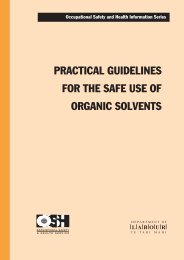
![Task analysis worksheet [161 KB PDF] - Business.govt.nz](https://img.yumpu.com/51400981/1/190x135/task-analysis-worksheet-161-kb-pdf-businessgovtnz.jpg?quality=85)

